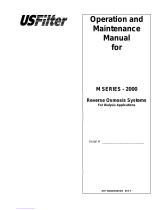www.unitylabservices.com/contactus
Diamond RO Low Purity Troubleshooting Guide
1) If the Reverse Osmosis (RO) membrane has not been changed in one year or more,
change the membrane.
2) With an independent conductivity meter, measure the conductivity of the inlet (feed)
water and the product water (water going to the RO system storage tank). With a
working RO membrane, the product water should have a conductivity value of at least
75% less than the inlet water (example: inlet water conductivity = 100 uS-cm, product
water should have a conductivity of 25 uS-cm or less). If a conductivity meter is not
available at your location, please call 866-984-3766 or email
Thermo Orion (800-225-1480) for information on purchasing a conductivity meter for
your lab to allow on-site testing capability.
3) Measure the product and reject water flow rates. Using a beaker and a timer, collect
water, for one minute, from the line that fills the RO storage tank. Record the flow rate in
liters per hour. Follow the same procedure to measure the flow of water coming from
the atmospheric drain. A working membrane should produce (at least) three times as
much reject (drain) water as product water.
4) Record the system pressures: prefilter inlet, prefilter outlet, carbon outlet, and
membrane pressure (ideal pressures are 20, 20, 15, 65 psi from top to bottom). To
record the pressures, the system must be in the Operating mode, where it is actively
making water. Water can be drained off from the RO reservoir, or the reservoir float
cable can be unplugged from the RO unit to trigger the system to make water. Ensure
that when the system is not making water, the gauges reset to zero. If the pressures are
incorrect, one (or all) of the prefilters likely needs changed.
5) Measure the feed water temperature. A temperature of 25 degrees Celsius is ideal.
Colder feed water slows down production, but should not harm the system unless
outside the feed water requirements as specified in the owner’s manual.


